Online shop
- Flexible CIGS solar panels
- Semi-flexible Solar Panels
- Rigid Frame Solar Panels
- Folding Solar Panels
- Semi-flexible Solar Kits
- Rigid Frame Solar Kits
- Dual Battery Solar Kits
- Solar Charge Controllers
- Wind Power
- Inverters
- Batteries
- Battery Chargers & Monitors
- Portable Power Stations
- Vehicle Power Management
- Complete Renewable Systems
- UPS Systems
- Solar Lighting Systems
- Cable
- Accessories
- Discounted Items
Didn't find products you were looking for?
Tell us about them! We might have these products in stock, but not on the website, or may be we are planning to restock them soon.
Testimonials:
Excellent pre-sales advice. Very quick despatch. Good build quality. Many Thanks
Richard (Hailsham, East Sussex, UK)
We are a trusted supplier to thousands of UK clients
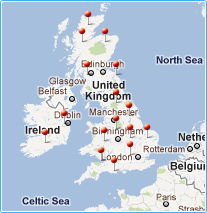
Solar Controller
How to choose a Solar Charge Controller
A solar charge controller( or regulator, as they are sometimes known) is an essential part of every solar charging kit. The main role of a controller is to protect and automate the charging of the battery. It does this in several ways:
1. REDUCING THE VOLTAGE OF YOUR SOLAR PANEL
- Without a controller between a solar panel and a battery, the panel would overcharge the battery by generating too much voltage for the battery to process, seriously damaging the battery.
- Overcharging a battery could result in the battery exploding!
2. MONITORING THE VOLTAGE OF YOUR BATTERY
- The controller detects when the battery’s voltage is too low. When the battery drops below a certain level of voltage, the controller disconnects the load from the battery in order to prevent the battery from being drained.
- A completely drained battery will lose some of its overall capacity.
- Low voltage can still damage the battery if the load is connected.
3. STOPPING REVERSE CURRENT AT NIGHT
- The controller stops any current from flowing back into the solar panel at night.
- This prevents any damage to your solar charging kit.
NOTE: The controller can also regulate current from the load when the load is connected to the controller. The load terminal on the controller is for direct connection of the load to the controller - unlike a wind turbine controller, it is NOT a load dump. The controller can still operate as normal if there is no load directly connected to it.
This diagram illustrates the connectivity of a typical solar power kit, including a solar panel, a solar charge controller, a battery and the load (e.g. a light bulb). The solar panel connects to the controller through positive and negative leads, only creating a charging function when the controller is connected to a battery. The load is then responsible for the discharging function from the controller (if it is connected to the controller).
NB: In some rare cases, a solar panel can be connected directly to a battery, without a controller. This can be achieved if the nominal voltage of the panel is lower than 17-18V, and if the solar panel is a lot smaller than the charging battery e.g.. a 10W panel charging a 100Ah battery.
There are many different types of controllers on the market. Choosing the right controller depends on the solar power system you would like to generate.
PWM controllers
A brilliant little device that boasts compatibility, simplicity, and a utilitarian understanding of solar panels, batteries, and loads: it is included in most of our small and medium sized kits. 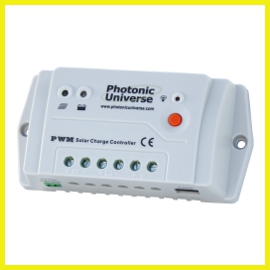
As it uses PWM technology, the amount of current and voltage that is lost between the panel and the battery is reduced to next to nothing. It can prolong battery life and also protect it from overcharging, undercharging, short circuiting, and overheating.
This charge controller does not have to be used solely on one panel and one battery; a 10A PWM controller cab be used to regulate the charge of an array of solar panels connected in parallel with a total power of 160W. If you were to get a 20A PWM controller, you would be able to regulate a solar panel bank of up to 320W for 12V batteries, and 640W for 24V batteries.The PWM controller can also be used to connect solar panels to a battery bank of 12V batteries, provided that the batteries are the same size and that they are in good condition. The 10A controller is also conveniently compact, at only 14 x 7 cm.
Controllers with LCD displays
The programmable features allow the user to customise the charging process by setting the battery type and the capacity, choosing charging voltages at each stage, setting protection parameters, and by switching the load on and off by timer. 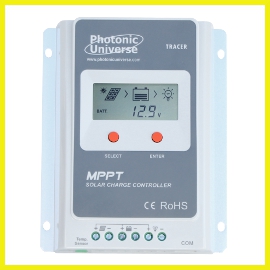
These controllers put the power in the owner’s hands, and makes a solar circuit much more advanced and controllable. An LCD display gives you information about many things, including:
-the solar panel current/voltage,the battery current/voltage
-the state of charge of the battery
-the temperature
-current charging stage
Dual battery controllers
This can be used to monitor and regulate two independent (electrically isolated) batteries at the same time. 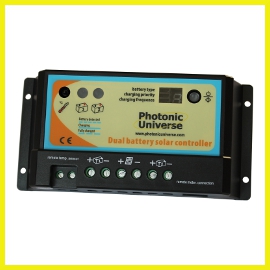
It is an essential item for anyone looking to charge both their leisure battery and their engine battery, or anyone who wants to charge a bank of several 12V leisure batteries and a starter battery at the same time.
The user has two charging options: to charge both of the connected batteries at an equal rate, or to give one battery charging priority (e.g. 80% of power to go to the engine battery and 20% to the leisure battery). A remote display can be equipped to this controller so that the user has more control over the regulation between the two batteries. Despite being called a “dual battery controller”, it can also be used to charge one battery - a second battery can be added later.
Waterproof controllers
These controllers are specifically designed for wet environments. 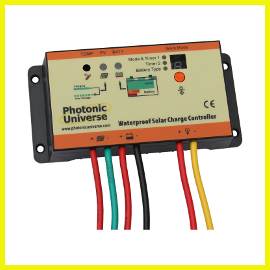
In terms of functionality, they are almost completely identical to the standard 10A PWM controller. It has multiple settings for timer-controlled load work, which is ideal for street lighting and perfect for anyone who wants to set up a solar charging kit on their boat.
MPPT controllers
Along with PWM, there is one other method of solar charge regulation that is considered the most efficient method: MPPT (Maximum Power Point Tracking). 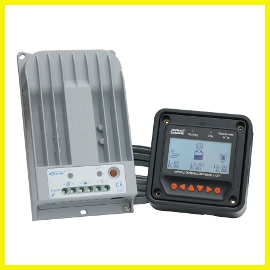
MPPT controllers are the most efficient and powerful controllers that we offer, but they should only be used when the solar panel voltage is much higher than the battery voltage. An MPPT system is able to lower the voltage of a panel (or an array of solar panels) that is up to ten times higher than the voltage of a battery to match the voltage of the battery without losing any of the current in the process. The MPPT controller works at a higher efficiency rate than the PWM controller; while a PWM controller operates at an efficiency level of 75%-80%, an MPPT controller operates at an efficiency rating of 92-95%.
MPPT controllers also boost the amount of current going to the battery, which can vary in amount depending on the weather, the temperature, the battery state of charge, and other factors. There would be no negative repercussions from using a MPPT controller on a solar panel with a voltage close to the battery voltage, but the benefits from MPPT in this sort of system would be much lower.
It has the same protective features as the PWM controllers. We include a 20A MPPT controller in our 200W/250W kits, due to the fact that an MPPT controller allows the panel to operate at the maximum level that it can. Some have built-in LCD displays, while others have RJ45 sockets for a remote meter that allow you to monitor the charging process.
We hope that this information will help you find the right controller. If you have any questions, please contact us and we will be happy to answer them.









